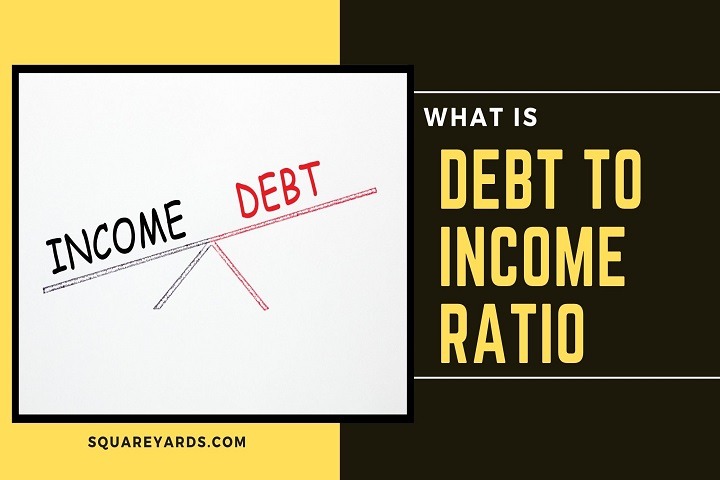A Debt-to-Income Ratio is defined as the percentage calculation of your overall monthly income and the portion of it that goes into the payments of debts. It is highly utilized by lenders to formulate your borrowing risk. Debt to income ratio can be called as a measuring tool of an organization or person’s income which can be used for servicing debt.
Usually, lenders go with 36% or less as the ideal debt ratio, but 43% is the highest percentage at which a borrower can be allowed to get a mortgage. Having a low debt-income ratio represents that the income is relatively good for servicing debt and makes the borrower more attractive in the eyes of the lender.
Table of contents
- An example of DTI Ratio
- Factors Formulating the DTI Ratio
- How to Achieve a Good Debt Ratio?
- DTI Calculation Formula
- The Importance of a Good Debt-to-Income Ratio
- What is an Ideal Debt Ratio?
- Limitations of the Debt-to-Income Ratio
- How Can One Lower their Debt-Income Ratio?
- Important Real estate Terms You Should Know
- FAQs
An example of DTI Ratio
If an individual pays $3000 as a monthly mortgage and $200 for the car insurance and $1000 for miscellaneous debts with a monthly income of $6000, the DTI ratio will be:
DTI Ratio- ($3000+$200+$1000)/$6000*100=70%
Factors Formulating the DTI Ratio
Lenders generally use two factors for determining the DTI ratio mortgage which is the back-end ratio and the front-end ratio. Here is a better picture of the two factors:
- The front-end ratio is also called the housing ratio as it determines the percentage of your income that goes into covering the expenses of your house including the property taxes, homeowners’ association dues, payment of the mortgage, and homeowners’ insurance.
- The back-end ratio, on the other hand, determines the portion of your income that will go into the monthly debt payments, mortgage payments, and housing expenses. These are inclusive of car loans, credit card payments, student or child support loans, and other debts that are present on your credit report.
How to Achieve a Good Debt Ratio?
You can reduce your debt-income ratio in two ways, either by increasing your income or by decreasing the levels of your debts. Usually, increasing the income is the tougher option out of the two. In case, a high DT ratio is restricting you from accessing the required credit, the lenders might suggest that you go for a co-signer or co-applicant for your loan whose income can be considered in your credit application. This might help get the needed credit, but it will not reduce your debt-to-income ratio.
DTI Calculation Formula
Mortgage lenders and other lenders determine your ability of monthly repayments through the DTI ratio and here is the debt-to-income ratio formula used for calculation:
DTI Ratio= Gross Monthly Income/Sum of Monthly Debt Payments
- Calculate the sum of your all-monthly payments including the credit card payments
- Divide the sum by your total monthly income
- The result will generate a decimal value hence, you need to multiply it by 100 to get the percentage
The Importance of a Good Debt-to-Income Ratio
Lenders take note of the debt amount that a customer can repay before facing any financial crunches and further use this information in setting up the lending amount. Hence, the DTI ratio stands important if you are looking to get a mortgage, loan, or credit because, without a decent DTI ratio, the lenders will not consider you as a potential borrower.
What is an Ideal Debt Ratio?
The specifications state that 43% is the highest percent at which a person can qualify for getting mortgages or loans. But usually, the lenders consider 36% or less to be the good debt ratio wherein 28% is the highest percentage that goes into the repayments of debts or loan repayments. Though the upper limit of the DTI ratio is different for different lenders, it is always better to have a low DTI ratio because it makes the borrower reliable in the eyes of the lender.
Limitations of the Debt-to-Income Ratio
A DTI ratio is free from the consideration of kinds of debts and the values that go in its repayment. For instance, credit cards have higher rates of interest in comparison to student loans, but both are merged to formulate a person’s debt-income ratio. The monthly payments of a card would decrease if your transfer the balance from a card with a high-interest rate to a card with low-interest rates. But this will only reduce your monthly payments and DTI ratio, the outstanding debt value will remain the same.
How Can One Lower their Debt-Income Ratio?
If your DTI ratio is over 36%, you need to take some steps to lower it down. Here’s what you can do:
- Increase the number of monthly debt payments because added payments will help you get rid of the loans quickly.
- Avoid adding another debt to your list. You should use your credit cards less and refrain from applying for a new loan.
- Since large purchases need more credit, do not indulge in any. With this, you will be able to make a large down payment and then you will need lesser credit for the purchase which will reduce your DTI ratio.
- Keep a monthly check on your debt-income ratio because if it falls, you will get motivated to manage your debts.
Important Real estate Terms You Should Know
| Super Built-up Area | What is Super Built-up Area |
| Annual Statement of Rates | What is Annual Statement of Rates |
| Fixed Rate Home Loan | What is a Fixed Rate Home Loan |
| Written Down Value | What is Written Down Value |
| Crowdfunding | What is Crowdfunding |
| National Building Codes | What are National Building Codes |
| Building Bye-Laws | What is Building Bye-Laws |
| Construction Loan | What is Construction Loan |
| Benami Property Transaction Act | What is Benami Property Transaction Act |
| Balloon Payment | What is Balloon Payment |
FAQs
What is a good percentage of the debt-to-income ratio?
36% or less is a good debt-income ratio.
Is car insurance considered in the debt-income ratio?
Yes, it is lumped to get the DTI ratio.
What bills are included in the debt-to-income ratio?
All the mortgage expenses including credit card payments, loan repayments, and housing expenses are considered in the debt-income ratio.
Is rent considered in the debt-to-income ratio?
No, your rent is not included in the debt-to-income ratio.




































